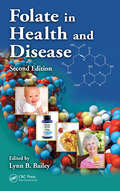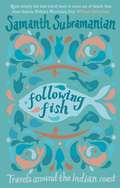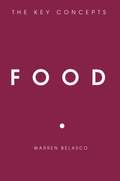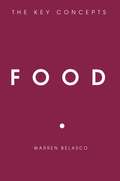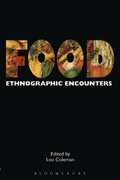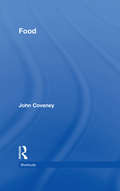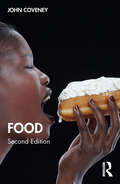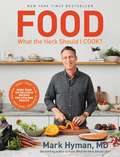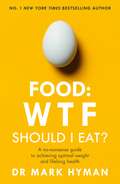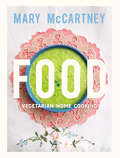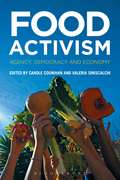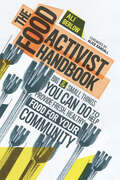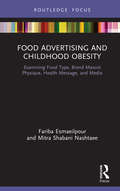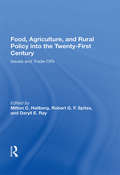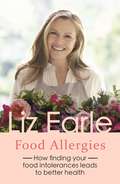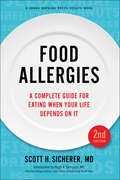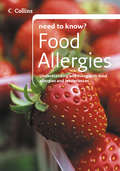- Table View
- List View
The FODMAP Friendly Kitchen Cookbook: 100 easy, delicious, recipes for a healthy gut and a happy life
by Emma HatcherChosen by the Telegraph and the Evening Standard as one of the best healthy eating books of 2017FODMAPs are a collection of molecules found in foods, that can cause issues for some people. A low-FODMAP lifestyle is the only diet recommended by the NHS to treat IBS and its associated symptoms. Emma Hatcher, creator of the blog She Can't Eat What?!, brings you 100 beautiful, healthy and delicious low FODMAP recipes.Emma Hatcher has suffered from a sensitive gut for as long as she can remember. After years of horrible symptoms and endless frustration trying different diets and cutting out various foods, her GP recommended the Low FODMAP Diet. FODMAP changed Emma's life and she has never looked back since. Emma's book, based on her hugely popular food and lifestyle blog She Can't Eat What?! will take the frustration out of living with IBS, Crohn's disease, coeliac's disease, food intolerances and many other digestive disorders. It is for anyone who suffers from bloating, tummy pains, digestive issues or feelings of heaviness and discomfort, and for anyone who wants to feel healthy and happy after eating.Backed by the official FODMAP Friendly team and with more than 100 quick, easy and modern recipes, diet information and personal stories for those that have run out of answers and feel 'they can't eat anything', Emma shows you how to create delicious meals and look after your gut in today's stress-filled, modern lifestyle.
Folate in Health and Disease
by Lynn B. BaileyDuring the fifteen years since the bestselling first edition of Folate in Health and Disease was published, there have been thousands of new research studies related to folate and its role in health and disease. The second edition of the book uniquely bridges the gap between basic science and public health/clinical medicine.Presents Groundbreaking
Following Fish: Travels Around the Indian Coast
by Samanth SubramanianShortlisted for the André Simon Food and Drink book awardsIn a coastline as long and diverse as India's, fish inhabit the heart of many worlds - food of course, but also culture, commerce, sport, history and society. Journeying along the edges of the peninsula, Samanth Subramanian delivers a kaleidoscope of extraordinary stories.Following Fish conducts rich journalistic investigations of, among others, the use of fish to treat asthmatics in Hyderabad; of the preparation and the process of eating West Bengal's prized hilsa; of the ancient art of building fishing boats in Gujarat; of the fiery cuisine and the singular spirit of Kerala's toddy shops; of the food and the lives of Mumbai's first peoples; of the history of an old Catholic fishing community in Tamil Nadu; and of the hunt for the world's fastest fish near Goa.Pulsating with pleasure, adventure and discovery, and tempered by nostalgia and loss, Following Fish reveals a series of unknown Indias in a book as revealing of the subcontinent as any three times its length.
Fondue & Raclette
by Louise PickfordFor ultimate winter indulgence, why not try a fondue! Indulge in fun retro food with a modern twist with this collection of delicious recipes created to share with family and friends. Starting with the well-known melted cheese fondues from ski resorts around the world, recipes here include classics from the Alps, such as the archetypal Fondue Neuchatel, based on local cheeses and local wines, and the variation Raclette. But there are others, too, such as a Roasted Tomato Fondue and the Italian version, Fonduta and hot oil Fondues to try such as Fondue Bourguignonne. Also included are some delicious lighter choices, like stock fondues where food is cooked in a scented broth – try Fish & Seafood in Saffron & Tomato Broth, and Beef with Horseradish in Red Wine & Juniper Stock. Also included are some up-to-the-minute, stylish Modern Fondues, such as Blue Cheese Fondue with Walnut Grissini. And don't forget the sweet fondues – there's Chocolate with Orange & Chilli, or White Chocolate Fondue with Lemon and Gin.
Food: The Key Concepts (The Key Concepts)
by Warren BelascoFood: The Key Concepts presents an exciting, coherent and interdisciplinary introduction to food studies for the beginning reader. Food Studies is an increasingly complex field, drawing on disciplines as diverse as Sociology, Anthropology and Cultural Studies at one end and Economics, Politics and Agricultural Science at the other. In order to clarify the issues, Food: The Key Concepts distills food choices down to three competing considerations: consumer identity; matters of convenience and price; and an awareness of the consequences of what is consumed. The book concludes with an examination of two very different future scenarios for feeding the world's population: the technological fix, which looks to science to provide the solution to our future food needs; and the anthropological fix, which hopes to change our expectations and behaviors. Throughout, the analysis is illustrated with lively case studies. Bulleted chapter summaries, questions and guides to further reading are also provided.
Food: The Key Concepts (The Key Concepts)
by Warren BelascoFood: The Key Concepts presents an exciting, coherent and interdisciplinary introduction to food studies for the beginning reader. Food Studies is an increasingly complex field, drawing on disciplines as diverse as Sociology, Anthropology and Cultural Studies at one end and Economics, Politics and Agricultural Science at the other. In order to clarify the issues, Food: The Key Concepts distills food choices down to three competing considerations: consumer identity; matters of convenience and price; and an awareness of the consequences of what is consumed. The book concludes with an examination of two very different future scenarios for feeding the world's population: the technological fix, which looks to science to provide the solution to our future food needs; and the anthropological fix, which hopes to change our expectations and behaviors. Throughout, the analysis is illustrated with lively case studies. Bulleted chapter summaries, questions and guides to further reading are also provided.
Food: Ethnographic Encounters (Encounters: Experience and Anthropological Knowledge #3)
by Leo ColemanFood preparation, consumption, and exchange are eminently social practices, and experiencing another cuisine often provides our first encounter with a different culture. This volume presents fascinating essays about cooking, eating, and sharing food, by anthropologists working in many parts of the world, exploring what they learned by eating with others.These are accounts of specific experiences - of cooking in Mombasa, shopping for organic produce in Vienna, eating vegetarian in Vietnam, raising and selling chickens in Hong Kong, and of refugees subsisting on food aid. With a special focus on the experience and challenge of ethnographic fieldwork, the essays cover a wide range of topics in food studies and anthropology, including food safety and food security, cultural diversity and globalization, colonial histories and contemporary identities, and changing ecological, social, and political relations across cultures.Food: Ethnographic Encounters offers readers a broad view of the vibrancy of local and global food cultures, and provides an accessible introduction to both food studies and contemporary ethnography.
Food
by John CoveneyThe centrality of food in life, and the importance of food as life, is undeniable. As a source of biological substrates, personal pleasure and political power, food is and has been an enduring requirement of human biological, social and cultural existence. In recent years, interest in food has increased across the academic, public and popular spheres, fuelled by popular media’s constant play on the role of food and body size, and food and cooking, as a mass spectacle for TV audiences. In Food, a new book part of the Shortcuts Series, John Coveney examines ‘food as…’ humanness, identity, politics, industry, regulation, the environment and justice. He explores how food helps us understand what it means to be human. Through food, we construct our social identities, our families and communities, but this book also highlights the tensions between the industrialisation of food, the environment, and the fair (or otherwise) worldwide distribution of food. It considers how the food industries, on which most of us have to rely, have also had direct effects on our bodies – whether through diet and longevity, or the development of illness and diseases. This book is for all students and general readers alike – or for anyone with a fascination with food. It questions the idea that food is merely something inert on the plate, and instead shows how influential, symbolic, powerful and transformative food has come to be. This book is part of the Shortcuts series published by Routledge, a major new series of concise, accessible introductions to some of the major issues of our times.
Food
by John CoveneyThe centrality of food in life, and the importance of food as life, is undeniable. As a source of biological substrates, personal pleasure and political power, food is and has been an enduring requirement of human biological, social and cultural existence. In recent years, interest in food has increased across the academic, public and popular spheres, fuelled by popular media’s constant play on the role of food and body size, and food and cooking, as a mass spectacle for TV audiences. In Food, a new book part of the Shortcuts Series, John Coveney examines ‘food as…’ humanness, identity, politics, industry, regulation, the environment and justice. He explores how food helps us understand what it means to be human. Through food, we construct our social identities, our families and communities, but this book also highlights the tensions between the industrialisation of food, the environment, and the fair (or otherwise) worldwide distribution of food. It considers how the food industries, on which most of us have to rely, have also had direct effects on our bodies – whether through diet and longevity, or the development of illness and diseases. This book is for all students and general readers alike – or for anyone with a fascination with food. It questions the idea that food is merely something inert on the plate, and instead shows how influential, symbolic, powerful and transformative food has come to be. This book is part of the Shortcuts series published by Routledge, a major new series of concise, accessible introductions to some of the major issues of our times.
Food
by John CoveneyIn Food, John Coveney examines ‘food as … ’ identity, politics, industry, regulation, the environment, justice and gastronomy. He explores how food helps us understand what it means to be human. The centrality of food in life, and the importance of food as life, is undeniable. As a source of biological substrates, personal pleasure and political power, food is and has been an enduring requirement of human biological, social and cultural existence. In recent years, interest in food has increased across the academic, public and popular spheres, fuelled by popular media’s constant play on the role of food and body size, and food and cooking, as a mass spectacle for TV audiences. Through food, we construct our social identities, our families and communities. However, Coveney also highlights the tensions between the industrialisation of food, the environment, and the iniquitous distribution of food. He also considers how the food industries, on which most of us must rely, have also had direct effects on our bodies through diet, and the development of illness and diseases. This accessible primer is for students and general readers alike, indeed, for anyone with an interest in food. It questions the idea that food is merely something inert on the plate. Instead, it shows how influential, symbolic, powerful and transformative food has come to be.
Food
by John CoveneyIn Food, John Coveney examines ‘food as … ’ identity, politics, industry, regulation, the environment, justice and gastronomy. He explores how food helps us understand what it means to be human. The centrality of food in life, and the importance of food as life, is undeniable. As a source of biological substrates, personal pleasure and political power, food is and has been an enduring requirement of human biological, social and cultural existence. In recent years, interest in food has increased across the academic, public and popular spheres, fuelled by popular media’s constant play on the role of food and body size, and food and cooking, as a mass spectacle for TV audiences. Through food, we construct our social identities, our families and communities. However, Coveney also highlights the tensions between the industrialisation of food, the environment, and the iniquitous distribution of food. He also considers how the food industries, on which most of us must rely, have also had direct effects on our bodies through diet, and the development of illness and diseases. This accessible primer is for students and general readers alike, indeed, for anyone with an interest in food. It questions the idea that food is merely something inert on the plate. Instead, it shows how influential, symbolic, powerful and transformative food has come to be.
Food: More than 100 Delicious Recipes--Pegan, Vegan, Paleo, Gluten-free, Dairy-free, and More--For Lifelong Health
by Dr. Mark HymanThe companion cookbook to Dr. Hyman's New York Times bestselling Food: What the Heck Should I Eat?, featuring more than 100 delicious and nutritious recipes for weight loss and lifelong health. Dr. Mark Hyman's Food: What the Heck Should I Eat? revolutionized the way we view food, busting long-held nutritional myths that have sabotaged our health and kept us away from delicious foods that are actually good for us. Now, in this companion cookbook, Dr. Hyman shares more than 100 delicious recipes to help you create a balanced diet for weight loss, longevity, and optimum health. Food is medicine, and medicine never tasted or felt so good.The recipes in Food: What the Heck Should I Cook? highlight the benefits of good fats, fresh veggies, nuts, legumes, and responsibly harvested ingredients of all kinds. Whether you follow a vegan, Paleo, Pegan, grain-free, or dairy-free diet, you'll find dozens of mouthwatering dishes, including:Mussels and Fennel in White Wine BrothGolden Cauliflower Caesar SaladHerbed Mini-Meatballs with Butternut NoodlesLemon Berry Rose Cream Cakeand many more With creative options and ideas for lifestyles and budgets of all kinds, Food: What the Heck Should I Cook? is a road map to a satisfying diet of real food that will keep you and your family fit, healthy, and happy for life.
Food: The no-nonsense guide to achieving optimal weight and lifelong health
by Mark HymanAre you confused about whether to go pegan, paleo, ketogenic or vegan? No 1 New York Times bestselling author Dr Mark Hyman sorts through the conflicting research on food to give us the truth on what we should be eating and why. Did you know that porridge isn't actually a healthy way to start the day? That perhaps you should be eating a Mediterranean diet? And that milk doesn't build bones, and eggs aren't the devil? In WTF Should I eat? - Dr Hyman looks at every food group and explains what we've gotten wrong, revealing which foods nurture our health and which pose a threat. He also explains the crucial role food plays in functional medicine and how food systems and policies affect our environmental and personal health.With myth-busting insights, easy-to-understand science, and delicious, wholesome recipes in every chapter, WTF Should I Eat? is an invaluable resource for cooking, eating and living well.'Dr Mark Hyman's WTF Should I Eat? offers a masterpiece of truth-telling, a subversive reproach to the industrial systems that threaten our very health - and how each of us can flourish by making better food choices. This could be the most useful book you will read.' - Daniel Goleman'I find that many people are confused about what constitutes a healthy diet. Food: WTF Should I Eat? is an easy to follow guide to the foods that harm us and the foods that heal us. If you want to take all of the guesswork out of eating a real, whole foods diet, read this book! - Dr. Rangan Chatterjee
Food: Vegetarian Home Cooking
by Mary McCartneyFood is full of uncomplicated, tasty meals to tempt both vegetarians and meat-eaters alike. Inspired by growing up as a vegetarian and working on her mother's recipes, and using stories and photographs (past and present) to tell her life through food, Mary has created recipes for friends and family that are imaginative and creative. Fresh, inspirational and irresistible, Mary's first cookbook will enthuse readers to bring more meat-free cooking into their repertoires. From Fruit and Nut Granola to Asparagus Tart, Mexican Bean Tortilla to Coconut Rice Pudding, Mary gives us ideas for every meal, from breakfasts to Sunday roasts, and offers new twists on old classics like pancakes, and Shepherd's Pie.As a working mother, Mary is perfectly placed to write a contemporary vegetarian cookbook - good food, cooked well and with ease, for all the family. And as a photographer she has a unique vision - her pictures are a glorious accompaniment to her mouth-watering food.
Food Activism: Agency, Democracy and Economy
by Carole Counihan Valeria SiniscalchiAcross the globe, people are challenging the agro-industrial food system and its exploitation of people and resources, reduction of local food varieties, and negative health consequences. In this collection leading international anthropologists explore food activism across the globe to show how people speak to, negotiate, or cope with power through food. Who are the actors of food activism and what forms of agency do they enact? What kinds of economy, exchanges, and market relations do they practice and promote? How are they organized and what are their scales of political action and power relations? Each chapter explores why and how people choose food as a means of forging social and economic justice, covering diverse forms of food activism from individual acts by consumers or producers to organized social groups or movements. The case studies embrace a wide geographical spectrum including Cuba, Sri Lanka, Egypt, Mexico, Italy, Canada, France, Colombia, Japan, and the USA. This is the first book to examine food activism in diverse local, national, and transnational settings, making it essential reading for students and scholars in anthropology and other fields interested in food, economy, politics and social change.
Food Activism: Agency, Democracy and Economy
by Carole Counihan Valeria SiniscalchiAcross the globe, people are challenging the agro-industrial food system and its exploitation of people and resources, reduction of local food varieties, and negative health consequences. In this collection leading international anthropologists explore food activism across the globe to show how people speak to, negotiate, or cope with power through food. Who are the actors of food activism and what forms of agency do they enact? What kinds of economy, exchanges, and market relations do they practice and promote? How are they organized and what are their scales of political action and power relations? Each chapter explores why and how people choose food as a means of forging social and economic justice, covering diverse forms of food activism from individual acts by consumers or producers to organized social groups or movements. The case studies embrace a wide geographical spectrum including Cuba, Sri Lanka, Egypt, Mexico, Italy, Canada, France, Colombia, Japan, and the USA. This is the first book to examine food activism in diverse local, national, and transnational settings, making it essential reading for students and scholars in anthropology and other fields interested in food, economy, politics and social change.
The Food Activist Handbook: Big & Small Things You Can Do to Help Provide Fresh, Healthy Food for Your Community
by Ali BerlowA valuable guide packed with practical ways you can support your local food community and create access to healthy food for everyone.
Food Advertising and Childhood Obesity: Examining Food Type, Brand Mascot Physique, Health Message, and Media (Routledge Studies in Marketing)
by Fariba Esmaeilpour Mitra Shabani NashtaeeThis book explores the ways in which the environmental factor of advertising can influence children’s food choice and health status, and how it contributes to the significant public health issue of childhood obesity. Food Advertising and Childhood Obesity seeks to gain a better understanding of children’s food choice based on children’s exposure to different advertising by analyzing food type, brand mascot physique, health messages, and media. The book begins by reviewing the ways in which children become consumers and the role of advertising in this process. It then explores a range of advertising variables in children’s food choice and consumption. This includes theoretical and practical discussion of foods and brand mascots, health messages embodied in food advertising, and comparisons of the effects of different advertising based on entertainment level, such as using new media to present ‘advergames’ supported by television advertising. Each chapter is supported with relevant theories and a research summary is presented on each topic for clarification. The book also introduces some ways of constructive working with children and concludes with a chapter dedicated to market research and children. Written for students and practitioners of marketing, market research, and advertising, especially within the global food industry, this book offers readers a new approach to understanding child food choice and consumption that will inform effective corporate social responsibility strategies to address this issue.
Food Advertising and Childhood Obesity: Examining Food Type, Brand Mascot Physique, Health Message, and Media (Routledge Studies in Marketing)
by Fariba Esmaeilpour Mitra Shabani NashtaeeThis book explores the ways in which the environmental factor of advertising can influence children’s food choice and health status, and how it contributes to the significant public health issue of childhood obesity. Food Advertising and Childhood Obesity seeks to gain a better understanding of children’s food choice based on children’s exposure to different advertising by analyzing food type, brand mascot physique, health messages, and media. The book begins by reviewing the ways in which children become consumers and the role of advertising in this process. It then explores a range of advertising variables in children’s food choice and consumption. This includes theoretical and practical discussion of foods and brand mascots, health messages embodied in food advertising, and comparisons of the effects of different advertising based on entertainment level, such as using new media to present ‘advergames’ supported by television advertising. Each chapter is supported with relevant theories and a research summary is presented on each topic for clarification. The book also introduces some ways of constructive working with children and concludes with a chapter dedicated to market research and children. Written for students and practitioners of marketing, market research, and advertising, especially within the global food industry, this book offers readers a new approach to understanding child food choice and consumption that will inform effective corporate social responsibility strategies to address this issue.
Food, Agriculture, And Rural Policy Into The Twenty-first Century: Issues And Trade-offs
by Milton C. HallbergThis book contributes to 1995 policymaking by offering information concerning an array of issues fundamentally important to the U.S. agricultural and food sector. It reviews a set of policy approaches for dealing with these issues, and assesses trade-offs among these alternative approaches.
Food, Agriculture, And Rural Policy Into The Twenty-first Century: Issues And Trade-offs
by Milton C. Hallberg Robert G. F. Spitze Daryll E. RayThis book contributes to 1995 policymaking by offering information concerning an array of issues fundamentally important to the U.S. agricultural and food sector. It reviews a set of policy approaches for dealing with these issues, and assesses trade-offs among these alternative approaches.
Food Allergies: How finding your food intolerances leads to better health (Wellbeing Quick Guides)
by Liz EarleLiz Earle explains why your body may be responding badly to some foods and helps you to find out which foods should be avoided to make you feel more energetic, slim and healthy.Bestselling beauty and wellbeing writer Liz Earle's fully revised and updated quick guide to food allergies, including:- An introduction to causes and types of allergies and intolerances- A guide to the most common food allergens and how to prevent them- Advice on how to detect if you have a food sensitivity- How to conduct an exclusion diet at home- Tips on preventing and detecting allergies in children
Food Allergies: A Complete Guide for Eating When Your Life Depends on It (A Johns Hopkins Press Health Book)
by Scott H. SichererPosing the urgent questions that anyone with food allergies will think to ask;¢;‚¬;€?and then some;¢;‚¬;€?Food Allergies provides practical, sensitive, and scientific guidance on the topics that affect your life. Allergy expert Scott H. Sicherer addresses the full spectrum of food allergies, from mild to life threatening and from single foods to food families, clearing up misconceptions along the way. He explores how exposure to foods can bring about an allergic response, describes the symptoms of food allergy, and illuminates how food allergies develop.Organized in an accessible Q&A format and illustrated with case studies, the book thoroughly explains how to prevent exposure to a known allergen at home, at school, in restaurants, and elsewhere. Dr. Sicherer also gives valuable advice about what to do if exposure occurs, including how to handle an anaphylactic emergency. Finally, he describes tests for diagnosing food allergies and chronic health problems caused by food allergies, such as eczema, hives, and respiratory and gastrointestinal symptoms.In this thoroughly updated new edition, Dr. Sicherer;€¢ describes new approaches to prevent food allergies;€¢ presents cutting-edge theories on risk factors for developing food allergies;€¢ describes innovative allergy tests to improve diagnosis;€¢ explains how to administer emergency medications for severe reactions;€¢ focuses on new allergens of concern, such as pink peppercorns;€¢ analyzes studies suggesting that resolution of an allergy might be predictable;€¢ talks about the role of "healthy diet";€¢ lists additional resources, including allergy-related apps;€¢ provides revised school food allergy guidelines;€¢ offers insights into food allergy bullying;¢;‚¬;€?and advice to reduce itDr. Sicherer also reviews food reactions that are not allergic (such as lactose intolerance and celiac disease), advises how to get adequate nutrition when you must avoid dietary staples, and discusses whether allergies ever go away (they do;¢;‚¬;€?and sometimes they return).
Food Allergies: A Complete Guide for Eating When Your Life Depends on It (A Johns Hopkins Press Health Book)
by Scott H. SichererPosing the urgent questions that anyone with food allergies will think to ask;¢;‚¬;€?and then some;¢;‚¬;€?Food Allergies provides practical, sensitive, and scientific guidance on the topics that affect your life. Allergy expert Scott H. Sicherer addresses the full spectrum of food allergies, from mild to life threatening and from single foods to food families, clearing up misconceptions along the way. He explores how exposure to foods can bring about an allergic response, describes the symptoms of food allergy, and illuminates how food allergies develop.Organized in an accessible Q&A format and illustrated with case studies, the book thoroughly explains how to prevent exposure to a known allergen at home, at school, in restaurants, and elsewhere. Dr. Sicherer also gives valuable advice about what to do if exposure occurs, including how to handle an anaphylactic emergency. Finally, he describes tests for diagnosing food allergies and chronic health problems caused by food allergies, such as eczema, hives, and respiratory and gastrointestinal symptoms.In this thoroughly updated new edition, Dr. Sicherer;€¢ describes new approaches to prevent food allergies;€¢ presents cutting-edge theories on risk factors for developing food allergies;€¢ describes innovative allergy tests to improve diagnosis;€¢ explains how to administer emergency medications for severe reactions;€¢ focuses on new allergens of concern, such as pink peppercorns;€¢ analyzes studies suggesting that resolution of an allergy might be predictable;€¢ talks about the role of "healthy diet";€¢ lists additional resources, including allergy-related apps;€¢ provides revised school food allergy guidelines;€¢ offers insights into food allergy bullying;¢;‚¬;€?and advice to reduce itDr. Sicherer also reviews food reactions that are not allergic (such as lactose intolerance and celiac disease), advises how to get adequate nutrition when you must avoid dietary staples, and discusses whether allergies ever go away (they do;¢;‚¬;€?and sometimes they return).
Food Allergies (Collins Need to Know?)
by Helen StraceyThis one-stop practical guide will show how to understand the allergies of yourself, your family and your friends. To make your progress easier, it comes in a handy two-colour format with expert tips and advice throughout.

